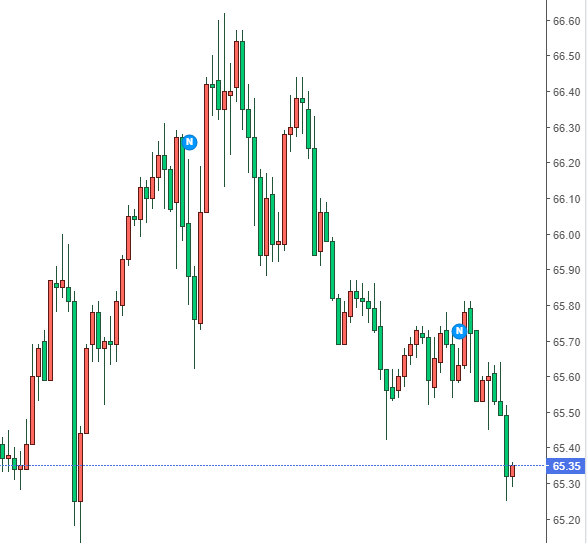
★
Summary
★
CPI rose the most since 2009 in April, according to the Labor Department. The rise in Treasury yields weakens the attractiveness of non-interest-bearing gold, while a stronger dollar makes gold more expensive in the eyes of other investors holding non-dollar currencies. As a result, WTI crude oil gave back more than 1 per cent from a high of $66.60 to consolidate below $66.00, but still recorded a third day of gains.
Data released by the labour department show that CPI, which measures a basket of commodities and energy and housing costs, rose 4.2 per cent in April from a year earlier, the fastest pace since September 2008; excluding volatile food and energy prices, core CPI in the US rose 3 per cent in April from a year earlier, the fastest pace since 1995, and 0.9 per cent month-on-month, well ahead of market expectations of 2.3 per cent and 0.3 per cent.
The market reaction to the impact of US CPI has been fully affirmed, believing that inflationary pressures in the US are likely to continue to rise against the backdrop of soaring commodity prices, the Biden administration's trillions of dollars stimulus package and rising labour costs, prompting the Fed to tighten monetary policy earlier. As a result, the three major US stock indexes fell sharply, with the Nasdaq and the S & P 500 all down more than 2%, and the three major US stock indexes showed warning signs of a three-day decline, while the yield on 10-year US Treasuries further climbed to 1.697%, an one-month high! After the dollar strengthened and rebounded to 90.80, WTI crude finally gave back most of its gains during the day and is now trimming around $65.70.

The US Energy Information Administration (EIA) said that apart from the lower-than-expected decline in commercial crude oil stocks in the strategic reserves, refined oil stocks fell slightly more than expected and gasoline stocks exceeded expectations. WTI crude oil futures, which at one point widened to 2% on the day, are now up 0.69% at $65.73 a barrel. In addition, EIA gasoline stocks in the United States actually announced an increase of 378000 barrels in the week ending May 7, with an expected increase of 737000 barrels, while EIA refinery stocks in the United States actually reported a decrease of 1.734 million barrels, expected to decrease by 1.5 million barrels, and the previous value decreased by 2.896 million barrels.
Domestic crude oil production in the United States increased by 100000 barrels to 11 million barrels per day last week, according to the EIA report. Us crude oil exports fell by 2.326 million b / d to 1.796 million b / d last week. The four-week average supply of crude oil products in the United States was 19.083 million barrels per day, an increase of 23.1% over the same period last year. The US Strategic Petroleum Reserve ((SPR)) fell 1.4 million barrels to 632 million barrels, compared with 633.4 million barrels. Excluding the commercial crude oil inventory of the strategic reserve, it decreased by 426000 barrels to 484.7 million barrels, or 0.1 per cent. With the exception of commercial crude oil from strategic reserves, 5.488 million barrels per day were imported last week, an increase of 37000 barrels per day over the previous week.
U. S. crude oil exports in the week to May 7 were the lowest since October 12, 2018. Crude oil stocks on the US East Coast fell to an all-time low last week. Last week, US refined oil stocks fell to their lowest level since April 2020. Us crude oil exports recorded the biggest drop in history, falling by 2.326 million barrels a day.
Market comments pointed out that the API report showed an unexpected increase in gasoline inventories, but did not shake the market's confidence that demand would recover. However, the EIA crude oil report showed that crude oil inventories fell only slightly, gasoline stocks increased slightly, the data was weaker than expected, and WTI crude oil futures fell slightly after the data were released. In addition, the data do not reflect the impact of disruptions in the Colonial Pipeline.
Looking to the future, the warming situation in the Middle East, Iran nuclear agreement, inflation and other factors are expected to further increase the volatility of oil prices in the future, especially the resistance of WTI crude oil above $68.0. investors should be on guard against the possibility of rising and falling. During the day, you can focus on the number of initial jobless claims in the United States in the week to May 8 and the monthly rate of PPI in the United States in April, which is expected to trigger market volatility.
Risk Warning: The above content is for reference only, and does not represent JRFX’s position. JRFX does not assume any form of loss caused by any trading carried out in accordance with this article. Please consult your financial planner for your investment portfolios and manage your own risk.
JRFX is an online CFD broker providing more than 50 products for Forex, metals and commodities. Open a trading account within a minute. Deposit 100USD and download our MT4 trading platform now!

|

|

|

|

Views: 116366

Likes: 0